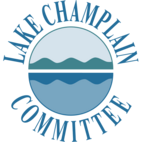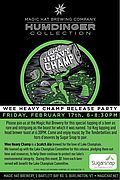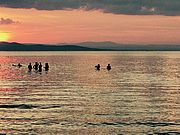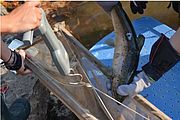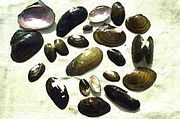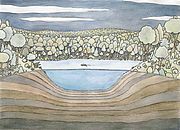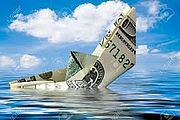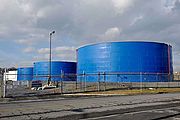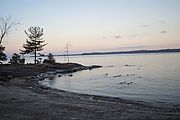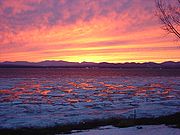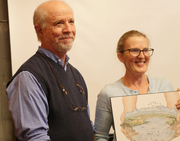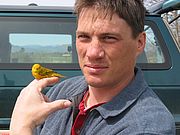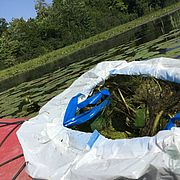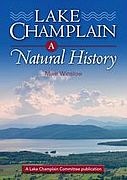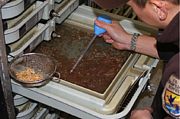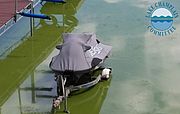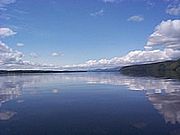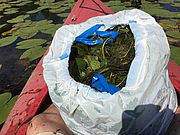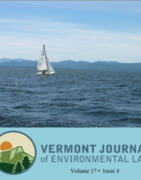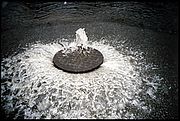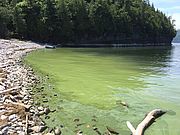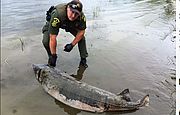Join us at Magic Hat Brewery on February 17 for a special tapping of Wee Heavy Champ -- a beer brewed for Lake Champlain!
Read...News from Selected Month
LCBP Program Director Eric Howe will deliver a summary of the updated version of Opportunities for Action.Read...
Follow an Atlantic salmon on its journey upstream to spawn in a tributary of Lake Champlain driven by its instincts (and a pickup truck).
Read...Every month, the Vermont's Clean Water Initiative Program highlights a "Clean Water Superstar", species that help keep waters swimmable, drinkable, and fishable. This month the spotlight is on mussels, the hardworking mollusks that filter algae, bacteria, and dead organic material out of the water.
Read...Walden Pond is a 62-acre kettle pond in sand and gravel that formed around a block of melting glacial ice about 15,000 years ago. It was here that Thoreau produced one of the first maps of an American lake bed by lowering a weighted line through winter ice.
Read...When Cory Williams moved from California to Alaska he skipped rocks across the ice-covered surface of Edmonds Lake and was wowed by the "coolest sound ever". Read...
Vermont lakeside communities would lose $16.8 million in economic activity and 200 full-time jobs - in July and August alone - for every one-meter (three-foot) decrease in water clarity according to a study recently released by the University of Vermont and the Lake Champlain Basin Program. Read...
The New York State Department of Environmental Conservation (DEC) has informed Global Partners LP that an air quality renewal permit for its Albany terminals, approved more than four years ago, would be considered as a new application, which requires the department to begin the environmental review process anew. Read...
New research suggests that Lake Champlain may be more susceptible to damage from climate change than was previously understood-and that, therefore, the rules created by the EPA to protect the lake may be inadequate to prevent algae blooms and water quality problems as the region gets hotter and wetter. Read...
Earlier this month, LCC joined with the Adirondack Mountain Club, National Wildlife Federation, Environmental Advocates of New York, and the City of Plattsburgh in opposition to a proposal to establish new anchorage grounds on the Hudson River. Read...
Winter brings to Lake Champlain, and to the many smaller lakes and ponds around the Lake Champlain Basin, a window into a world where the normal rules of life are suspended. Read...
Earlier this year, LCC honored Mike Kline, manager of the Rivers Program at the VT Dept. of Environmental Conservation with our Legacy Award. Read...
After 15 1/2 years as LCC Staff Scientist, Mike Winslow left LCC earlier this year for a post at the VT Experimental Program to Stimulate Competitive Research(EPSCoR). Read...
New invasive species were found in three lakes in our region this past summer: Indian Lake, Lake Bomoseen, and Lake Alice. Read...
Why is ice so hard and slippery? Does Lake Champlain produce lake-effect snow? Why does fog form over the lake on cold days? Read...
Vermont Governor-elect Phil Scott recently named civil engineer Julie Moore to head the Vermont Agency of Natural Resources in his administration. Read...
After being devastated by Tropical Storm Irene in 2011, the White River National Fish Hatchery was closed and its decades-long Atlantic salmon restoration effort dropped. Five years and roughly $2.4 million later the hatchery is rebuilt and raising fish once again. Read...
Lake Champlain reached record levels in the spring of 2011 from storm events and snowmelt. These floods devastated communities. State and local communities are acting now to be better prepared for future floods. Read...
This video from France beautifully illustrates how human and natural communities are safer and healthier through the protection of natural flows, floodplains and meandering rivers. Read...
On Facebook? We are too! 'Like' LCC's Facebook page for engaging content, the latest lake news, and beautiful lake photos. Read...
Cyanobacteria blooms are still present in areas of Lake Champlain and some inland lakes. Calm and sunny weather is in the forecast so blooms may persist for several more weeks in some areas. Read...
Mixed conditions reported again this week. Read LCC's latest blue-green algae report for more information. Read...
LCC monitors reported alert conditions for several locations in St. Albans Bay, Missisquoi Bay, and the Inland Sea and at some inland lakes this week. Read LCC's weekly report and check conditions carefully before recreating. Keep people and pets away from scummy or green water and report any suspected blooms to LCC right away. Read...
Blooms showed up in various sections of Lake Champlain and inland lakes this week. Monitors reported mixed conditions around Lake Champlain. Read...
After EPA released a final phosphorus <link learn news item the-limits-of-epas-pollution-plan-for-lake-champlain>Total Maximum Daily Load for Lake Champlain in June, the state of Vermont now has the responsibility for assuring the pollution loads identified can be met. Read...
For several years LCC has collaborated with Arrowwood Environmental to conduct surveys for aquatic invasive species in the Lake Champlain watershed. Read...
The Vermont Journal of Environmental Law dedicated an entire issue to Lake Champlain. Read...
A new rule to address combined sewer overflows (CSOs) was recently approved in Vermont. Combined sewer systems collect both sewage and stormwater in the same pipe. Read...
LCC volunteer blue-green algae monitors have contributed nearly 1,000 reports of conditions around the lake so far this summer. Read...
A dead six foot nine inch sturgeon washed ashore in Isle La Motte earlier this month. Read...
